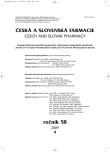Determination of the constituents of propolis of different geographical origin
Authors:
J. Muselík 1; R. Masteiková 1; V. Suchý 2; Z. Chalupová 1; V. Ostrá 1
Authors‘ workplace:
Veterinární a farmaceutická univerzita Brno, Farmaceutická fakulta, Ústav technologie léků
1; Veterinární a farmaceutická univerzita Brno, Farmaceutická fakulta, Ústav přírodních léčiv
2
Published in:
Čes. slov. Farm., 2009; 58, 179-183
Category:
Original Articles
Overview
The structural diversity of propolis constituents, due to a larger number of plant sources, is the cause of diverse composition and the hitherto unsolved standardization. The principal share in the biological effects is ascribed to flavonoids and aromatic acids and their derivatives. The results presented in this paper illustrate the diversity of the compositions of ten propolis samples obtained from different regions of the Czech Republic and three samples from abroad. Attention was paid to the determination of polyphenols, content of flavones and flavonols and the assay of antioxidative activity. The results confirmed the variability of the parameters under study as well as the presence of chrysin, galangin, p-coumaric, ferulic, cinnamic and benzoic acids in dependence on the area of collection. It will be difficult to elaborate a method of standardization suitable for possible administration of propolis preparations. In the future, propolis could become a raw material for the isolation of individual groups of biologically active substances.
Key words:
propolis – flavonoids – phenolic acids – antioxidative activity – liquid chromatography
Sources
1. Banskota, A. H., Tezuka, Y., Kadota, S.: Phytother. Res., 2001; 15, 561–571.
2. Lu, L. C., Chen, Y. W., Chou, C. C.: Int. J. Food Microbiol., 2005; 102, 213–220.
3. Borrelli, F. et al.: Fitoterapia, 2002; 73 Suppl. 1, 53–63.
4. Sawaya, A. C. H. F. et al.: Lett. Appl. Microbiol., 2002; 35, 203–207.
5. Moreira, L. et al.: Food Chem. Toxicol., 2008; 46, 3482–3485.
6. Sforcin, J. M.: J. Ethnopharmacol., 2007; 113, 1–14.
7. Banskota, A. H. et al.: Phytomedicine, 2001; 8, 16–23.
8. Gekker, G. et al.: J. Ethnopharmacol., 2005; 102, 158–163.
9. Lucrecia, L. et al.: Food Sci. Technol., 2009; 42 1422–1427.
10. Hegyi, E., Suchý, V., Nagy, M.: Hautarzt, 1990; 41, 675–679.
11. Hausen, B. M. et al.: Contact Dermatitis, 1987; 17, 163–170.
12. Hausen, B. M. et al.: Contact Dermatitis, 1987; 17, 171–177.
13. Bankova, V.: J. Ethnopharmacol., 2005; 100, 114–117.
14. Šmejkal, K. et al.: Molecules, 2007; 12, 1210–1219.
15. Trusheva, B., Trunkova, D., Bankova, V.: Chem. Cent. J., 2007; 1, 1–4.
Labels
Pharmacy Clinical pharmacologyArticle was published in
Czech and Slovak Pharmacy

2009 Issue 4
Most read in this issue
- Standard prescriptions for the formulation of medicinal preparations in pharmacies III Some possibilities of using isopropyl alcohol
- Determination of the constituents of propolis of different geographical origin
- Studies of the properties of tablets from directly compressible isomalt
- Determination of the coating thickness of HPMC hard capsules by near-infrared reflectance spectroscopy
